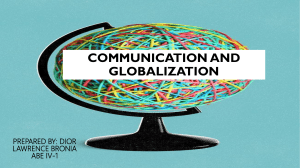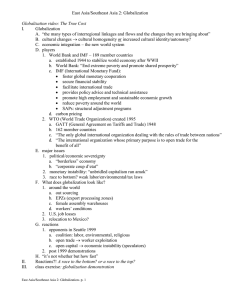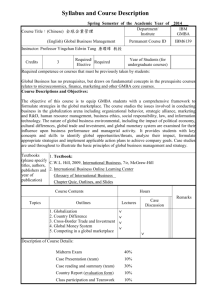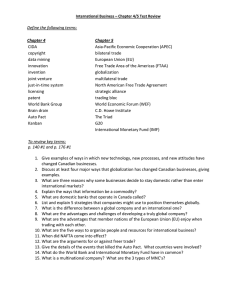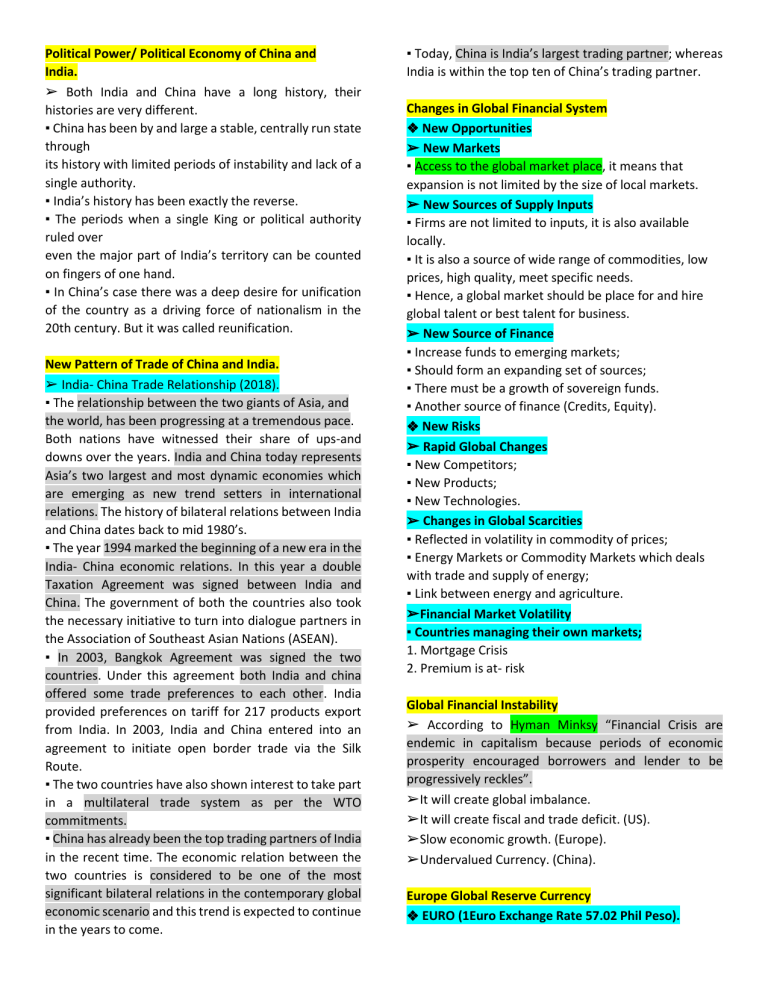
Political Power/ Political Economy of China and India. ➢ Both India and China have a long history, their histories are very different. ▪ China has been by and large a stable, centrally run state through its history with limited periods of instability and lack of a single authority. ▪ India’s history has been exactly the reverse. ▪ The periods when a single King or political authority ruled over even the major part of India’s territory can be counted on fingers of one hand. ▪ In China’s case there was a deep desire for unification of the country as a driving force of nationalism in the 20th century. But it was called reunification. New Pattern of Trade of China and India. ➢ India- China Trade Relationship (2018). ▪ The relationship between the two giants of Asia, and the world, has been progressing at a tremendous pace. Both nations have witnessed their share of ups-and downs over the years. India and China today represents Asia’s two largest and most dynamic economies which are emerging as new trend setters in international relations. The history of bilateral relations between India and China dates back to mid 1980’s. ▪ The year 1994 marked the beginning of a new era in the India- China economic relations. In this year a double Taxation Agreement was signed between India and China. The government of both the countries also took the necessary initiative to turn into dialogue partners in the Association of Southeast Asian Nations (ASEAN). ▪ In 2003, Bangkok Agreement was signed the two countries. Under this agreement both India and china offered some trade preferences to each other. India provided preferences on tariff for 217 products export from India. In 2003, India and China entered into an agreement to initiate open border trade via the Silk Route. ▪ The two countries have also shown interest to take part in a multilateral trade system as per the WTO commitments. ▪ China has already been the top trading partners of India in the recent time. The economic relation between the two countries is considered to be one of the most significant bilateral relations in the contemporary global economic scenario and this trend is expected to continue in the years to come. ▪ Today, China is India’s largest trading partner; whereas India is within the top ten of China’s trading partner. Changes in Global Financial System ❖ New Opportunities ➢ New Markets ▪ Access to the global market place, it means that expansion is not limited by the size of local markets. ➢ New Sources of Supply Inputs ▪ Firms are not limited to inputs, it is also available locally. ▪ It is also a source of wide range of commodities, low prices, high quality, meet specific needs. ▪ Hence, a global market should be place for and hire global talent or best talent for business. ➢ New Source of Finance ▪ Increase funds to emerging markets; ▪ Should form an expanding set of sources; ▪ There must be a growth of sovereign funds. ▪ Another source of finance (Credits, Equity). ❖ New Risks ➢ Rapid Global Changes ▪ New Competitors; ▪ New Products; ▪ New Technologies. ➢ Changes in Global Scarcities ▪ Reflected in volatility in commodity of prices; ▪ Energy Markets or Commodity Markets which deals with trade and supply of energy; ▪ Link between energy and agriculture. ➢Financial Market Volatility ▪ Countries managing their own markets; 1. Mortgage Crisis 2. Premium is at- risk Global Financial Instability ➢ According to Hyman Minksy “Financial Crisis are endemic in capitalism because periods of economic prosperity encouraged borrowers and lender to be progressively reckles”. ➢It will create global imbalance. ➢It will create fiscal and trade deficit. (US). ➢Slow economic growth. (Europe). ➢Undervalued Currency. (China). Europe Global Reserve Currency ❖ EURO (1Euro Exchange Rate 57.02 Phil Peso). ➢ Global Reserve System – US dollar remains the world’s currency reserve due to primarily to the fact that countries accumulated so much of it, and that it was still the most stable and liquid form of exchange. ❖ Current system is FRAYING ➢ Fraying definition is usually disorderly or protracted fight, struggle, or dispute. ▪ Changes the value overtime; ▪ Growing lack of confidence in dollar; ▪ Major source of global savings; ➢ Globalization has meant the world is more interconnected; what happens in one part of the world has impact on the other parts of the world. Climate Change – is a long term change in the average weather patterns that have come to define earths local, regional and global climates. These changes has a broad range of observed effects that are synonymous with the term. ❖Global warming – a continued warming of the atmosphere as a result of mankind's activities. ▪ Climate change will affect everyone but some populations will be at greater risk. For example, countries whose coastal regions have a large population, such as Egypt and China, may see whole populations move inland to avoid flood. The effect on people will depend on how well we can adapt to the changes and how much we can do to reduce global climate change. Global Marketing Global marketing is more than simply selling a product internationally. Rather, it includes the whole process of planning, producing, placing, and promoting a company’s products in a worldwide market. • Large businesses often have offices in the foreign countries they market to; but with the expansion of the Internet, even small companies can reach customers throughout the world. ❖ Economic Exchange (Global Affairs); ▪ Economic behaviour involves the exchange of one scarce resource for another. When people engage in paid work, they exchange their scarce time, effort, and skill for income, and, when people make purchases, they exchange their scarce income for scarce goods and services. Economic activity is driven by the need to exchange. Three ways to count the total GDP; 1. Output ▪ This method counts the sum of value added created through the production of goods and services within the economy. The sum value is the total value of the whole economy subtracted by the cost of intermediary goods. 2. Income ▪ This method counts the total income generated by the production of goods and services within the economy, including income earned by companies, employees, and self-employed people. This method is the middle ground between the output method and the expenditure method. 3. Expenditure ▪ This method counts the total expenditure on all finished goods and services produced within the economy. The GDP mainly comes from consumers who buy services and goods. Global Economy of 21st Century ❖ Global Challenges & Opportunities: Strategy for the 21st Century; ➢ Global Challenges; ▪ Financial Instability ▪ Rising levels of unemployment ▪ Persistent poverty ▪ Ecological Imbalances ▪ Widening Inequality ▪ Nuclear Proliferation ▪ Social tensions, unrest and terrorism Market Integration International Financial Institutions (IFI’s) are institutions that provide financial support via grants and loans for economic and social development activities in developing countries. include public banks, such as World Bank, International Monetary Fund and Regional development banks provide loans, grants and technological assistance to governments as well as loans to private business investing in developing countries plays significant role in the privatization and regulations of public utilities and natural resources Classification of IFI: 1. World Bank 2. International Monetary Fund (IMF) 3. European Investment Bank (EIB) 4. Islamic Development Bank (IsDB) 5. Asian Development Bank (ADB) 6. European bank for Reconstruction and Development (EBRD) 7. CAF – Development Bank of Latin America (CAF) 8. Inter- American Development Bank Group (IADB) 9. African Development Bank (AfDB) 10. Asian Infrastructure Investment Bank (AIIB) Goals of World Bank ✓ The World Bank is a vital source of financial and technical assistance to developing countries around the world. 1. End extreme poverty by decreasing the percentage of people living on less than $1.90 a day to no more than 3%. 2. Promote shared prosperity by fostering the income growth of the bottom 40% for every country. Organizations of World Bank 1. The International Bank for Reconstruction and Development (IBRD). 2. The International Development Association (IDA). 3. The International Finance Corporation (IFC). 4. The Multilateral Investment Guarantee Agency (MIGA). 5. The International Centre for Settlement of Investment Disputes. International Monetary Fund ✓ The International Monetary Fund (IMF) is an organization of 189 countries, working to foster global monetary cooperation, secure financial stability, facilitate international trade, promote high employment and sustainable economic growth, and reduce poverty around the world Mission of International Monetary Fund 1. Surveillance – the IMF oversees the International Monetary System and monitors the economic and financial policies of its 189 member countries. 2. Lending – A core responsibility of the IMF is to provide loans to member countries experiencing actual or potential balance of payments problems. 3. Capacity Development – IMF capacity development – technical assistance and training – helps member countries design and implement economic policies that foster stability and growth by strengthening their institutional capacity and skills. Market Integration – Is a term that is used to identify a phenomenon in which markets of goods and services are somehow related to one another being to experience similar patterns of increase or decrease in terms of prices of those products. – The term can also refer to a situation in which the prices of related goods and services sold in a defined geographical location also begin to move in some sort of similar pattern to one another. – Integration, may be intentional with a governmental implementing certain strategies as a way to control the direction of the economy. – Integrating of the markets may be due to factors such as shifts and demand that have spillover effect on several markets. ❑ Markets Integration and How it Works; ✓ Koester of 2017 states that market integration is a state of affairs or a process involving attempts to combine separate national economies into larger economic regions. ✓Integration as a means of stimulating trade and improving divisions of labor among countries has been recommended by many economists. ✓ integration can be achieved by different means. Reducing non- tariff and tariff barriers to trade can be the main tool for integrating markets. Forms of Integration ✓ According to Koester of 2017, the following are the forms of Integration. 1. Preferential Agreement – it involves lower trade barriers between those countries which have signed the agreement. 2. Free Trade Agreement – it reduces barriers to trade among member countries to zero, but each member country still has autonomy in deciding on the external rate of tariff for its trade with nonmember countries. Example: European Free Trade. 3. Customs Union – it represents a higher stage of economic integration than a free trade. 4. Common Market – It goes beyond a Customs Union in allowing for free movement of labor and capital within the Union. 5. Economic Union – It is the highest form of economic integration. Example: Conditions of a common market, member countries also agree to integrate monetary, fiscal and other policies. The European Integration ✓The European Integration is a unique economic and political union between 28 European countries that together cover much of the continent. ✓The EU was created in the aftermath of the second world war. The first steps were to foster economic cooperation; the idea being that countries that trade with one another become economically interdependent and so more likely to avoid conflict. The Four Pillars of the ASEAN Economic Community 1. Single Market and Production Base – the region as a whole must become a single market and production base to produce and commercialize goods and services anywhere in ASEAN. 2. Competitive Economic Region – the region must emphasize on the competitiveness of its production and capacity for export, as well as the free competition inside of its frontiers. 3. Equitable Economic Development – to receive the benefits of the EAC, the people and business of ASEAN must be engaged into the integration process of the AEC. 4. ASEAN’s integration into the globalized economy – ASEAN must not be isolated but an integrated part of the global economy. Core Principles of the ASEAN single market and production base; 1. Free flow of goods 2. Free flow of services 3. Free flow of investment 4. Free flow of Capital 5. Free flow of skilled labor Globalization – Refers to the trend towards a more integrated global economic system. Two key facets of globalizations are: 1. The globalization of Markets 2. Globalization of production Globalization of Markets - merging of historically distinct and separate national markets into one huge global marketplace. Globalization of Production - sourcing of goods and services from locations around the globe to take advantage of national differences in the cost and quality of factors of productions like labor energy, land and capital. The Emergence of Global Institutions 1. World trade Organizations (WTO) – which of responsible for policing the world trading system and ensuring that nations adheres to the rules established by WTO treaties. 2. International Monetary Fund (IMF) – which maintains order in the international monetary system. 3. Word Bank – which promotes economic development. 4. United Nations (UN) – which maintains international peace and security, develops friendly relations among nations, cooperates in solving international problems and promotes respects for human rights and is a center for harmonizing the actions of nations. United Nations ✓ The United Nations is considered as the world’s leading international organization that has an indispensable part of the global political arena. ✓ The United Nation Charter clearly spelled out the following basic principles of International Relations; 1. To maintain international peace and security; 2. To develop friendly relations among nations; 3. To cooperate in solving International problems and in promoting respect for human rights; and 4. To be a center for harmonizing the actions of nations. Anti- Globalization Protests ✓ Anti- globalization protesters now turn up at almost every major meeting of a global institution. ✓ Protesters fear that globalization is forever changing the world in a negative way. Ethics 1. Sarbanes Oxley Act – Protect Investors. 2. Utilitarian Approach – It strives to achieve the greatest good for the greatest number. 3. Kantian Ethics – always respect humanity in others. 4. The Friedman Doctrine – Business Ethics – monetary policy and quantity theory pf money became known as monetarism. 5. Universal Declaration of Human Rights – rights and freedom of individuals. 6. The righteous moralist 7. Ethical Dilemma 8. The naïve Immoralist 9. Ethical Strategy International Trade 1. Exports and Imports – Export Management – Balance of Payments Account – Current account Balance of Trade Equilibrium 2. Restrictions on Trade – Tariffs – Import Quotas – Administrative Trade Policies 3. Free Trade Theories - Trade Creation 4. Counter Trade – Buybacks – Barter – Offset – Switch Off – Counter Purchase Religion and Globalism clash over the fact that religious evangelization is in itself a form of globalization. 5 major religions Judaism 1. Monotheism 2. Ten Commandments of moral and religious conduct 3. Torah: Written records and beliefs of the Jews 4. Founder: Abraham 1. Followers are called Jews 2. Believe that God made a covenant with Abraham and his people (Israelites) 3. Adherents are worldwide, but most are in Israel 4. Holy book is the Torah (= the first five books of the Old Testament of Christian Bible) 5. Worship in a Synagogue Christianity Christianity 1. Monotheism 2. Jesus as Son of God 3. Life after death 4. New Testament: Life and teachings of Jesus 5. Establishment of Christian doctrines by early church councils 6. Worship in a church 7. Holy Book: Bible Islam 1. Monotheism 2. Muslim name for their God is Allah 3. Muhammad, the prophet 4. Holy Book: Qur’an (Koran) 5. Mecca and Medina 6. Started his religion in Mecca, Saudi Arabia. This is the holiest city in 7. Muslims worship in a mosque 8. Muslims must follow the Five Pillars of Islam: a. Stating the Faith b. Prayer 5 times/day facing Mecca c. Charity to poor d. Pilgrimage (Hajj) e. Fast during Ramadan Buddhism 1. Founder: Siddhartha Gautama (Buddha) 2. Four Noble Truths 3. Eightfold Path to Enlightenment 4. Spread of Buddhism from India to China and other parts of Asia, resulting from Asoka’s missionaries and their writings 5. Basic Tenets of Buddhism a. The world is full of suffering b. Meditation is our only escape c. Nirvana is the ultimate goal d. Follow the Eightfold Path Hinduism 1. Many forms of one god 2. Reincarnation: Rebirth based upon karma 3. Karma: Knowledge that all thoughts and actions result in future consequences. Eightfold Path 1. Right Understanding 2. Right Thought 3. Right Speech 4. Right Action 5. Right Livelihood 6. Right Effort 7. Right Mindfulness 8. Right Concentration Caste System a. Good Karma b. Ok Karma c. Bad Karma d. Untouchables Hindu Gods a. Vishnu b. Shiva c. Brahma

